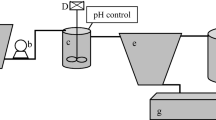Abstract
Glyphosate, the most widely used herbicide in the world, is routinely applied to control weeds in both agricultural and urban settings. Glyphosate wastewater that has been treated with Fenton’s reagent has a high phosphorus content and has the potential to cause environmental pollution. However, the high phosphorus concentration means that it may be possible to recover phosphorus from the glyphosate-rich wastewater. To date there have been relatively few studies on phosphorus removal from glyphosate wastewater. We therefore carried out a pilot scale study to investigate phosphorus recovery from this wastewater using chemical coagulation and evaluated the effect of various parameters, such as the initial pH, reaction time, coagulant dosage and type of coagulant. The experimental results demonstrate that a total phosphorus removal efficiency of about 68% was achieved for glycine wastewater and that total phosphorus removal efficiencies from N-(Phosphonomethyl) iminodiacetic acid wastewater and wastewater containing 6% glyphosate exceeded 90% under optimal reaction conditions.






Similar content being viewed by others
References
An J, Li N, Wang S, Liao C, Zhou L, Li T, Wang X, Feng Y (2019) A novel electro-coagulation-Fenton for energy efficient cyanobacteria and cyanotoxins removal without chemical addition. J Hazard Mater 365:650–658
Chhetri RK, Klupsch E, Andersen HR, Jensen PE (2018) Treatment of Arctic wastewater by chemical coagulation, UV and peracetic acid disinfection. Environ Sci Pollut Res 25:32851–32859
Conrad A, Schroeter-Kermani C, Hoppe H-W, Ruether M, Pieper S, Kolossa-Gehring M, Conrad A (2017) Glyphosate in German adults of human exposure to a widely used herbicide. Int J Hyg Environ Health 220(2017):8–16
Deng W, Yang Q, Chen Y, Yang M, Xia Z, Zhu J, Chen Y, Cai J, Yuan S (2020) Cyhalofop-butyl and glyphosate multiple-herbicide resistance evolved in an eleusine indica population collected in chinese direct-Seeding Rice. J Agric Food Chem 68:2623–2630
Ghisi NDC, Zuanazzi NR, Carrenho Fabrin TM, Oliveira EC (2020) Glyphosate and its toxicology: a scientometric review. Sci Total Environ 7:33
Huntscha S, Stravs MA, Buhlmann A, Ahrens CH, Frey JE, Pomati F, Hollender J, Buerge IJ, Balmer ME, Poiger T (2018) Seasonal dynamics of Glyphosate and AMPA in Lake Greifensee: rapid microbial degradation in the epilimnion during summer. Environ Sci Technol 52:4641–4649
Hussain S, Awad J, Sarkar B, Chow CWK, Duan J, van Leeuwen J (2019) Coagulation of dissolved organic matter in surface water by novel titanium (III) chloride: mechanistic surface chemical and spectroscopic characterisation. Sep Purif Technol 213:213–223
Jiang X, Ouyang Z, Zhang Z, Yang C, Li X, Dang Z, Wu P (2018) Mechanism of glyphosate removal by biochar supported nano-zero-valent iron in aqueous solutions. Colloid Surfaces a-Physicochem Eng Asp 547:64–72
Martin-Dominguez A, Rivera-Huerta ML, Perez-Castrejon S, Garrido-Hoyos SE, Villegas-Mendoza IE, Gelover-Santiago SL, Drogui P, Buelna G (2018) Chromium removal from drinking water by redox-assisted coagulation: Chemical versus electrocoagulation. Sep Purif Technol 200:266–272
Meng X, Wu J, Kang J, Gao J, Liu R, Gao Y, Wang R, Fan R, Khoso SA, Sun W, Hu Y (2018) Comparison of the reduction of chemical oxygen demand in wastewater from mineral processing using the coagulation-flocculation, adsorption and Fenton processes. Miner Eng 128:275–283
Mesnage R, Phedonos A, Biserni M, Arno M, Balu S, Corton JC, Ugarte R, Antoniou MN (2017) Evaluation of estrogen receptor alpha activation by glyphosate-based herbicide constituents. Food Chem Toxicol 108:30–42
Nivelle E, Verzeaux J, Chabot A, Roger D, Chesnais Q, Ameline A, Lacoux J, Nava-Saucedo J-E, Tetu T, Catterou M (2018) Effects of glyphosate application and nitrogen fertilization on the soil and the consequences on aboveground and belowground interactions. Geoderma 311:45–57
Tang Q-Y, Luo X-L, Yang S-Y, Xu Y-H (2020) Novel Z-scheme In2S3/BiVO4 composites with improved visible-light photocatalytic performance and stability for glyphosate degradation. Sep Purif Technol 2:48
Tarazona JV, Court-Marques D, Tiramani M, Reich H, Pfeil R, Istace F, Crivellente F (2017) Glyphosate toxicity and carcinogenicity: a review of the scientific basis of the European Union assessment and its differences with IARC. Arch Toxicol 91:2723–2743
Van Bruggen AHC, He MM, Shin K, Mai V, Jeong KC, Finckh MR, Morris JG Jr (2018) Environmental and health effects of the herbicide glyphosate. Sci Total Environ 616:255–268
Vandenberg LN, Blumberg B, Antoniou MN, Benbrook CM, Carroll L, Colborn T, Everett LG, Hansen M, Landrigan PJ, Lanphear BP, Mesnage R, vom Saal FS, Welshons WV, Myers JP (2017) Is it time to reassess current safety standards for glyphosate-based herbicides? J Epidemiol Community Health 71:613–618
Yuan Y, Jiang J, Liu S, Yang J, Zhang H, Yan J, Hu X (2017) Fluorescent carbon dots for glyphosate determination based on fluorescence resonance energy transfer and logic gate operation. Sensor Actuat B-Chem 242:545–553
Zhang H-C, Yang Y-J, Ma K-X, Shi C-Y, Chen G-W, Liu D-Z (2020b) A novel sigma class glutathione S-transferase gene in freshwater planarian Dugesia japonica: cloning, characterization and protective effects in herbicide glyphosate stress. Ecotoxicology 29:295–304
Zhang F, Xu Y, Liu X, Pan L, Ding E, Dou J, Zhu B (2020a) Concentration distribution and analysis of urinary glyphosate and its metabolites in occupationally exposed workers in Eastern China. Int J Environ Res Public Health 17:63
Zou T, Jin C, Zhu Z, Hu Y (2019) Detection of glyphosate resistance in black nightshade Solanum nigrum from Hunan China. Scienceasia 45:419–424
Acknowledgements
Financial support from the Ministry of Science and Technology of China for National Key Research and Development Program of China (2016YFC0400708) is gratefully acknowledged.
Author information
Authors and Affiliations
Corresponding author
Ethics declarations
Conflict of interest
No potential conflict of interest was reported by the authors.
Additional information
Editorial responsibility: Josef Trögl.
Rights and permissions
About this article
Cite this article
Liu, D., Zhou, S. Application of chemical coagulation to phosphorus removal from glyphosate wastewater. Int. J. Environ. Sci. Technol. 19, 2345–2352 (2022). https://doi.org/10.1007/s13762-021-03164-x
Received:
Revised:
Accepted:
Published:
Issue Date:
DOI: https://doi.org/10.1007/s13762-021-03164-x




